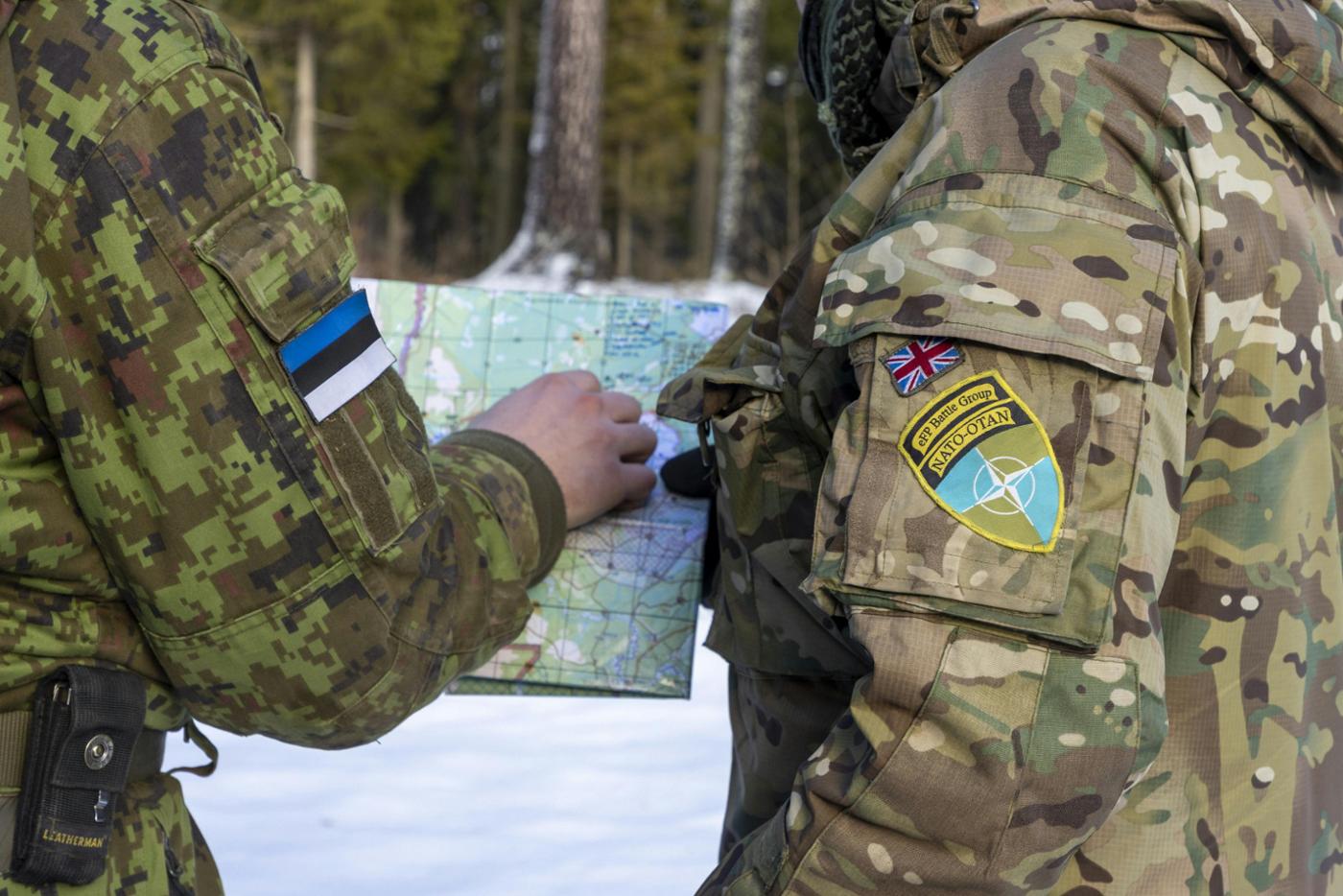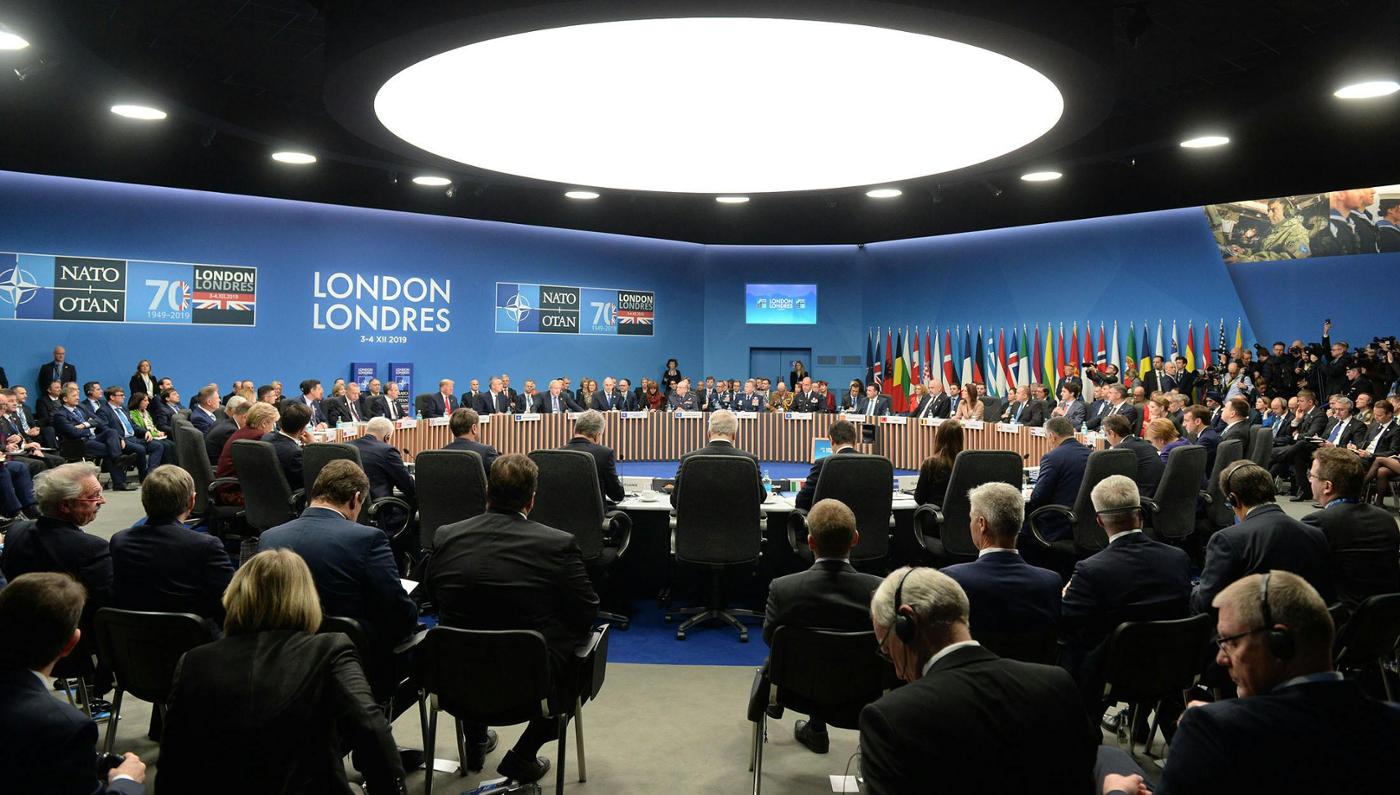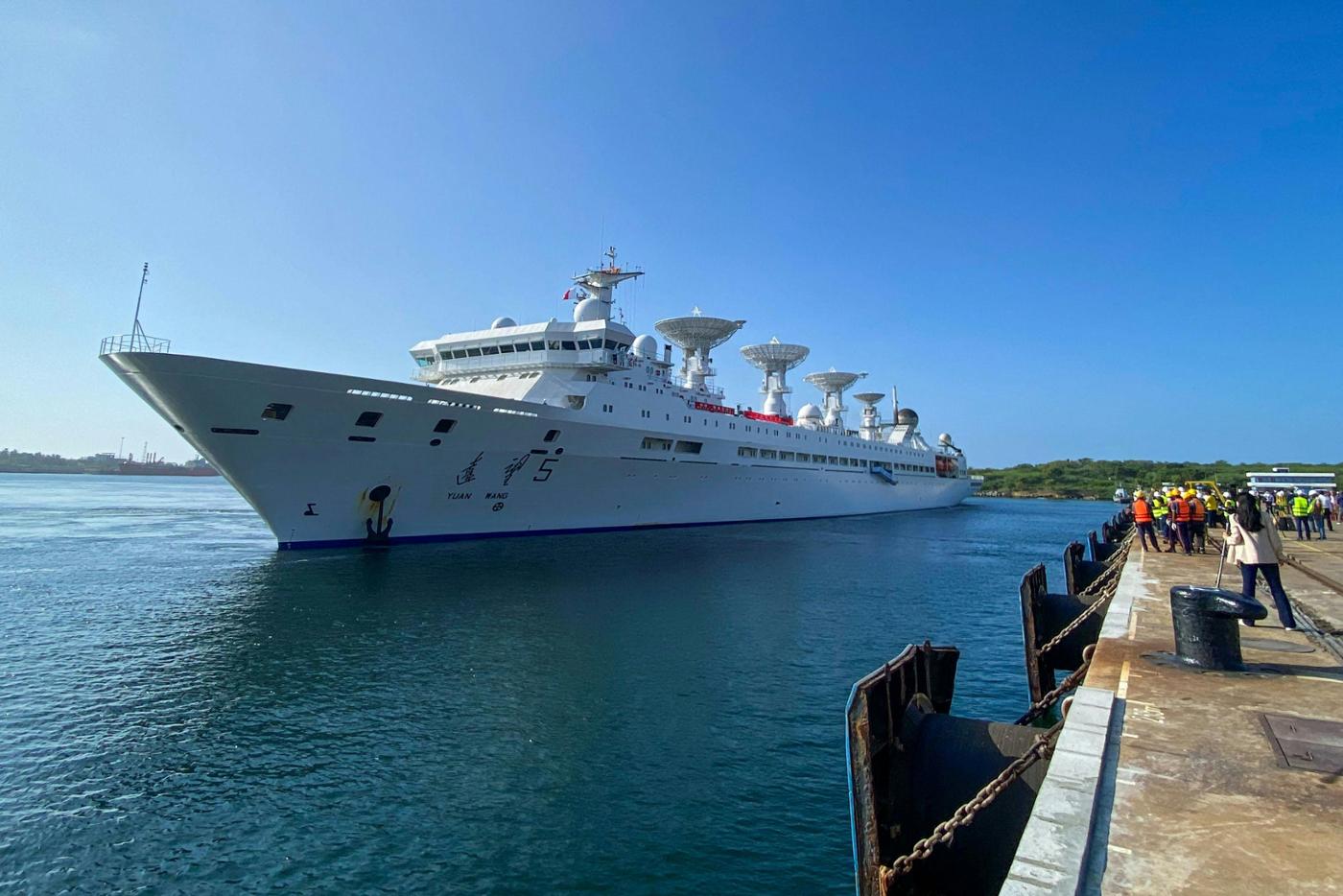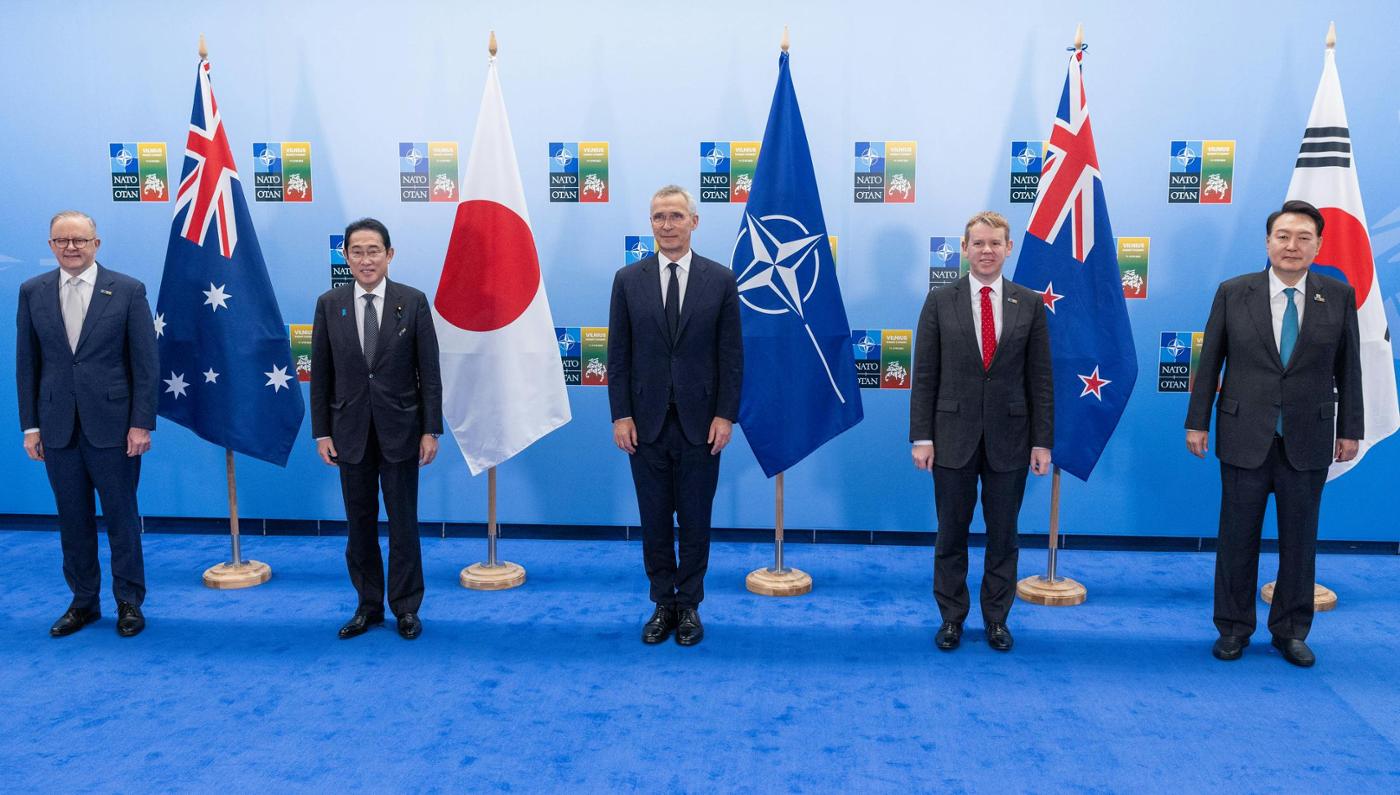The war in Ukraine has underscored the growing geopolitical interdependence between the Euro-Atlantic and Indo-Pacific regions. For one, China has helped Russia cushion Western economic and political pressure.
Indeed, Beijing’s image in Europe (which has been on a downward trajectory for years) has tanked as the perception of tacit support for Moscow’s assault on the Euro-Atlantic security order and global norms has spread. Conversely, diplomatic, economic and military support from Indo-Pacific partners like Australia, Japan, New Zealand and the Republic of Korea has helped to strengthen Ukraine’s resilience and uphold global norms. More broadly, the war has triggered an intense debate in the United States about how to reconcile the need to assist Ukraine while maintaining focus on the threat that China poses in the Indo-Pacific. This debate continues to raise questions about the implications of U.S. prioritisation for transatlantic relations and European security.

Due to the ongoing war in Ukraine, NATO continues to strengthen its presence and deterrence in the eastern part of the Alliance. Pictured: a British soldier and an Estonian soldier from the multinational battlegroup. Photo courtesy of the British Army.
To be sure, the war has underlined NATO’s centrality in the Euro-Atlantic security order. Assisting Ukraine and strengthening deterrence in the eastern part of the Alliance have become NATO’s top political and strategic priorities. However, Allies recognise the increasing relevance of China’s strategic rise and Indo-Pacific geopolitical dynamics for Euro-Atlantic security, as well as their importance to global military competition, technological innovation and economic growth. Indeed, debates on how to deal with the challenges around China’s strategic rise or how to strengthen cooperation with key partners in the Indo-Pacific region have gained traction in NATO circles as of recently. That said, ongoing Allied reservations about framing China as a security threat to NATO or directly engaging in the Indo-Pacific generate some uncertainty around the scope and future of NATO’s China and Indo-Pacific agendas or, for that matter, whether and how they relate to each other. I aim to provide an overview of NATO’s evolving China and Indo-Pacific policies, and discusses some of the key challenges and opportunities going forward.
NATO and China
NATO’s growing interest in China has developed against the backdrop of Beijing’s designation as a “long-term strategic competitor” in the 2017 U.S. National Security Strategy, and Europe’s growing realisation about the strategic implications of China’s rise. Both the Trump and Biden administrations have sought to expand transatlantic cooperation on China, motivated by the belief that greater European support to US policies is key to effectively addressing the economic, political and strategic challenges associated with China’s growth. While Washington has put much emphasis on discussing with the EU and individual European countries how best to tackle the geo-economic, technological and diplomatic challenges associated with China’s rise and behaviour, NATO has also become an increasingly important vector of transatlantic cooperation on China.
China was officially recognised as an important topic to NATO for the first time at the 2019 London summit, when the Alliance’s Heads of State and Government argued that Beijing’s “growing influence and international policies present both opportunities and challenges that we need to address together as an Alliance”. That statement paved the way for an increasingly substantial debate within NATO, with the US – supported primarily by the UK – consistently urging Allies to think more seriously about the strategic implications of China’s rise. Since then, some Allies have continued to raise questions about NATO’s China agenda, worrying it could sever their political and economic cooperation with Beijing, as well as insisting that the Alliance should focus on its core mandate (Euro-Atlantic security) and refrain from expanding its geographical or functional remit, not least given the need to give priority to eastern Europe.
The 2019 London declaration was followed by “NATO 2030”, a consultation process launched by the Secretary General to reflect on the Alliance’s future direction, which included a report by an independent group of experts. The fact that the 2030 Reflection Group report was not an official NATO document gave the drafters greater latitude on a whole range of issues, including China. Notably, the report alerted Allies to the “simultaneous geopolitical and ideological challenges posed by Russia and China”, and urged NATO to “remain the platform around which the Alliance organises itself for an era of truly global challenges”. In doing so, the case was made for transcending a narrow geographical or functional interpretation of NATO: while recognising the centrality of security in the Euro-Atlantic region, the 2030 report also underlined NATO’s political nature and global scope, thus aiming to set the foundations for a more substantial China agenda. Also interestingly, the report linked the need to tackle the China challenge globally and address simultaneous geopolitical and ideological competition to the strengthening of cooperation with key partners in the Indo-Pacific, notably Australia, Japan, New Zealand and the Republic of Korea. It even advocated for “beginning internal discussions about a possible future partnership with India”. Albeit not an official NATO document, the 2030 report arguably constitutes the most far-reaching NATO-adjacent statement on China to date, and has helped pave the way for a more substantial discussion within the Alliance.
In the 2021 Brussels Summit Communiqué, NATO Leaders devoted two full paragraphs to China, in which they explicitly affirmed that “China’s stated ambitions and assertive behaviour present systemic challenges to the rules-based international order and to areas relevant to Alliance security”. They also pointed to a number of concrete problems, such as the expansion of China’s nuclear arsenal, its growing military cooperation with Russia, its civil-military fusion strategy and its actions in space, cyber-space and disinformation. At the same time, the Communiqué reiterated the importance of keeping an open dialogue with China.

China was officially recognised as an important topic for NATO at the 2019 London summit, when the Alliance’s Heads of State and Government argued that Beijing’s “growing influence and international policies present both opportunities and challenges that we need to address together as an Alliance”. Pictured: NATO Leaders during the meeting of the North Atlantic Council in London, 4 December 2019. © NATO
Building on the Brussels Summit, the Strategic Concept approved by Allies the following year at the 2022 Madrid Summit offers a detailed analysis of how China’s actions challenge core NATO values and interests, and denounces China’s use of economic leverage to create strategic dependencies. It puts emphasis on China’s and Russia’s mutually reinforcing attempts to undercut the rules-based international order, which run counter to our values and interests, and warns about the need to “protect against [China’s] coercive tactics and efforts to divide the Alliance”. This summer, at the 2023 summit in Vilnius, in addition to reaffirming the language from Madrid, NATO Leaders urged China “to condemn Russia’s war of aggression against Ukraine, abstain from supporting Russia’s war effort, to cease amplifying Russia’s false narrative blaming Ukraine and NATO for Russia’s war of aggression against Ukraine, and to adhere to the purposes and principles of the UN Charter”.
Three levels of analysis
NATO’s China agenda can arguably be broken down into three levels of analysis. The first is global, and relates to the notion that China is the only country that can really pose a sustained and multidimensional challenge to the international system. This idea features prominently in the 2022 US National Security Strategy and is increasingly reflected in NATO language, though China is often lumped together with other ‘authoritarian actors’. Seen through this light, China constitutes a challenge to an international system that still largely reflects transatlantic values and interests.
The second level relates to the fact that China challenges Euro-Atlantic security in a number of ways. Some of these are more direct and have to do with the fact that China has globally reaching naval, cyber, space or ICBM capabilities, with China’s military presence in the Baltic or Mediterranean seas by way of exercises and port visits, and with its critical infrastructure holdings in Europe. This concerns NATO’s direct area of responsibility – and could affect the Alliance’s logistics, military mobility and communications therein – but also Africa and the Middle East. There is thus a growing consensus within the Alliance that China’s global capabilities and activities within the broader Euro-Atlantic must be closely monitored. In turn, China’s tacit support of Russia’s assault on the European geopolitical architecture poses a more indirect challenge to Euro-Atlantic security, but arguably a more relevant one for NATO, as was recognised explicitly in the 2022 Strategic Concept and 2023 Vilnius Summit Communiqué.
The third level of analysis, which affects NATO less directly but is arguably the most important one, relates to China’s challenge to the Indo-Pacific security architecture. Even though NATO remains first and foremost a Euro-Atlantic security organisation, there is growing recognition that China’s challenge to Indo-Pacific security is both systemically relevant – given the Indo-Pacific’s economic, technological and strategic centrality in global politics – and immensely consequential for the United States, and thus indirectly NATO – given America’s centrality to Euro-Atlantic security.
NATO’s debate on China has suffered from a significant degree of compartmentalisation, arguably to appease the more skeptical Allies. Yet, the growing recognition that the aforementioned “global”, “Euro-Atlantic” and “inter-theater” dimensions bleed into each other is giving way to a more coherent NATO approach towards China.
NATO and the Indo-Pacific
The Alliance’s cooperation with key partners in the Indo-Pacific (i.e. Australia, Japan, New Zealand and the Republic of Korea) has an established history. The fact that these countries are all treaty allies of the United States already underscores their high level of compatibility with the Alliance in terms of security outlook, military standards as well as political values. Even though efforts to develop informal ties with Indo-Pacific countries go back to the Cold War years, the Alliance has primarily developed its formal mechanisms for political cooperation with third parties in the post-Cold War period.
In the 1990s, the Alliance launched dedicated regional partnership dialogues with countries in the broader Euro-Atlantic neighbourhood, namely the former Soviet space, the Mediterranean and the Middle East. NATO has also maintained ad-hoc political dialogues with other countries, including those in the Indo-Pacific. It was, however, in the context of NATO’s engagement in Afghanistan that more concrete opportunities to formalise many of these partnerships arose. Indeed, NATO’s operation in Afghanistan presided over a period of growing cooperation between many of these partners and the Alliance, politically, financially and even operationally – with Australia standing out through its contribution of significant forces.

China has globally reaching naval capabilities. China’s military is present in the Baltic and Mediterranean seas by way of exercises and port visits. Pictured: Chinese research ship Yuan Wang 5, also called ‘spy ship’ docks at Sri Lanka’s Hambantota port on 16 August 2022. © CNN
From 2010 onwards, NATO created a mechanism called Individual Tailored Cooperation Packages of Activities, which allows it to structure cooperation with so-called Partners Across the Globe, a category that to date includes Australia, Colombia, Iraq, Japan, the Republic of Korea, Mongolia, New Zealand, Pakistan and Afghanistan – though that partnership is currently suspended. Yet, it was only as recently as the 2030 reflection process that NATO began to have meetings with its four Indo-Pacific partners simultaneously, thus underscoring the importance of the region. The decision to invite the leaders of these partners to the Madrid and Vilnius summits constitutes yet another symbolic step in this regard. However, bilateral ties and the individual partnership agreements remain the main vehicles of cooperation, not least due to important divergences in terms of how different partners in the Indo-Pacific region conceive of their relationship with NATO.
Addressing the challenges associated with China’s rise and strengthening cooperation with Indo-Pacific partners are clearly linked, not least as these countries – especially Japan and Australia – have grown increasingly wary about China’s rise in recent years. Indeed, NATO Allies realise that their dialogue with Indo-Pacific countries can help them to better understand the challenges associated with China’s rise. However, the dialogue between NATO and its Indo-Pacific partners generally sidesteps explicit links to either China or a role for NATO in the Indo-Pacific region itself, as both parties are interested in framing their cooperation in ‘positive’ terms and dispelling the notion of a NATO expansion to the Indo-Pacific. Partly as a result of this, NATO cooperation with Indo-Pacific partners is framed by and large in broad, transnational terms, by emphasising the need to uphold global norms, tackle transnational challenges like terrorism or the climate-security nexus, and identifying areas like cyber or disinformation as the most promising areas for furthering cooperation.
Way ahead
Despite recent progress – notably at the Madrid and Vilnius summits – an underlying tension continues to loom over NATO’s Indo-Pacific and China agendas. On the one hand, there is a growing recognition in NATO circles that geostrategic dynamics in the Euro-Atlantic and Indo-Pacific regions are increasingly intertwined, and both NATO Allies and Indo-Pacific countries are progressively worried about deterrence in a great power context. On the other hand, the Alliance maintains political caveats about framing China as a security threat to NATO, and directly engaging in the Indo-Pacific. This is further compounded by the fact that both NATO and its Indo-Pacific partners - understandably - prioritise their respective regions. There are questions about the scope or limits of NATO’s China and Indo-Pacific agendas, which are often framed either too broadly (i.e. emphasising the need to uphold global rules and tackle transnational threats) or too narrowly (by pointing to China’s military activities in the Euro-Atlantic or identifying niche areas for cooperation with Indo-Pacific countries). This is paradoxical.
For one thing, NATO and its Indo-Pacific partners have very similar strategic and operational priorities: how to strengthen deterrence in the face of great power revisionism, and how to generate the forces, operational concepts, capabilities and technologies required to that end. Even if their main threat referent or area of responsibility is indeed different, the fact that the challenges they face are so similar underlines the existence of important synergies and the potential for structured cooperation in key areas like operational planning, capability development or military-technological innovation.

Official photo of NATO Secretary General Jens Stoltenberg with the Leaders of NATO’s partner countries in the Indo-Pacific at the Vilnius Summit, 12 July 2023. Left to right: Prime Minister of Australia Anthony Albanese, Prime Minister of Japan Fumio Kishida, NATO Secretary General Jens Stoltenberg, Prime Minister of New Zealand Christopher Hipkins, President of the Republic of Korea Suk Yeol Yoon. © NATO
For another, deterring China in the Indo-Pacific is likely to put a permanent strain on US military planning and resources – which constitute the centre of gravity of Euro-Atlantic security. While there may be no need for Allied headquarters or permanent military assets in the Indo-Pacific, this means the Alliance should have eyes and ears in the Indo-Pacific, and be prepared to react to an Indo-Pacific contingency by both assisting US military efforts therein and filling possible US force gaps in the Euro-Atlantic region. This requires stronger links with relevant regional-level strategic and tactical commands (notably INDO-PACOM), with Japan and Australia (given their centrality to Indo-Pacific deterrence); via more military-to-military dialogues and exercises, educational exchanges and track 1.5 dialogues. Relatedly, strengthening the link between the North Atlantic Council and Indo-Pacific partners, and between the partners and relevant NATO bodies and processes in areas like defence planning, capability development or military innovation would help provide key US allies with a better idea of existing military gaps in each other’s region, help them anticipate undue pressures on US strategic bandwidth, identify ways to address or mitigate against such pressures, and generate capability, industrial and technological synergies.
Post-Vilnius, NATO needs to think harder about how to close the gap between its core focus (i.e. strategic competition and deterrence in a great power context), and its China and Indo-Pacific agendas. Critically, the emphasis should be on improving the Alliance’s awareness of how a China contingency in the Indo-Pacific may affect US military resources and planning, and on mutual learning between NATO and Indo-Pacific partners in operational planning or the development of joint capabilities and technologies, rather than direct operational engagement in each other’s regions. That way, putting deterrence at the centre of NATO’s China and Indo-Pacific agendas can be reconciled with existing political and strategic caveats.
